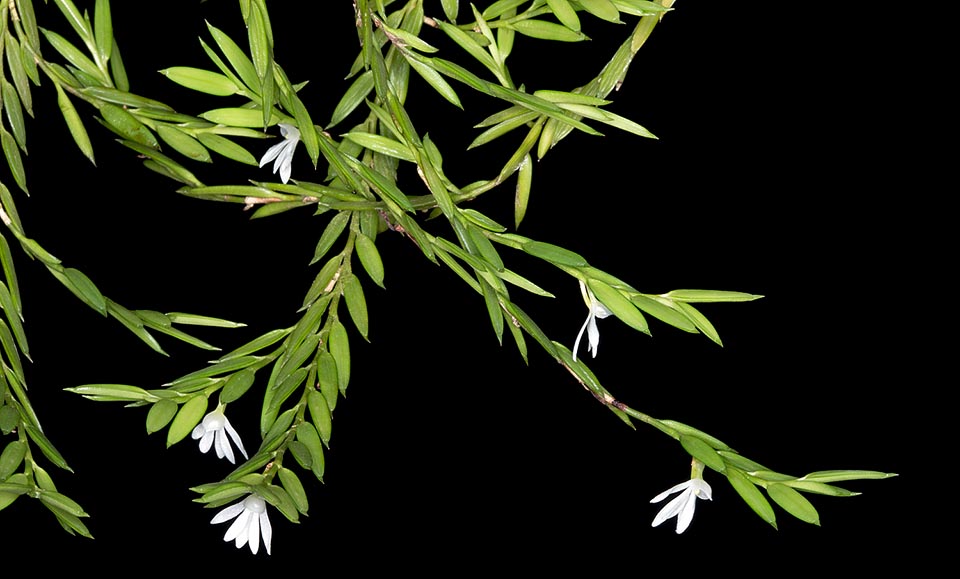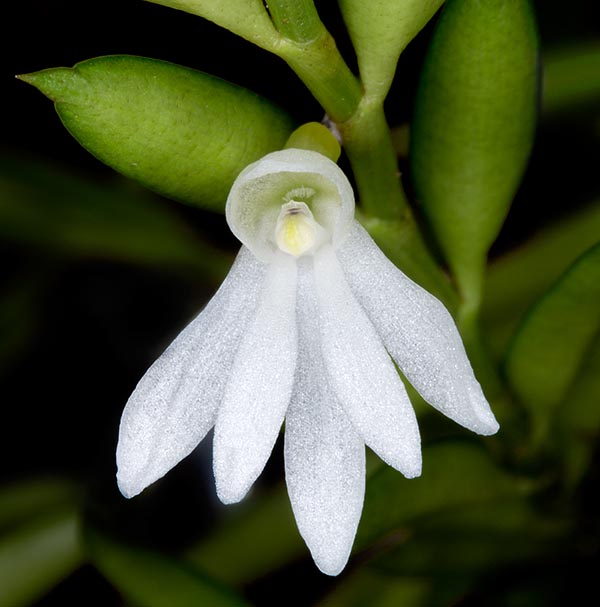Family : Orchidaceae

Text © Pietro Puccio

English translation by Mario Beltramini

Epiphyte with dense tufts, with 1 mm stems even 35 cm long, the Angraecum gabonense is native to the humid tropical forests of West Africa © Giuseppe Mazza
The species is native to Cameroon, Democratic Republic of the Congo, Equatorial Guinea, Gabon and Gulf of Guinea Islands where it lives in the dense humid forests, from the sea level up to about 1800 m of altitude.
The name of the genus comes from the Malay one, “angurek”, utilized for epiphytic orchids; the specific name refers to one of the places of origin, the Gabon. Common names: the Gabon Angraecum (English).
The Angraecum gabonense Summerh. (1954) is an epiphytic species forming dense tufts with thin ascending or drooping stems, ramified, up to about 35 cm long and of 1 mm of diameter, with 2,5-5 mm long internodes.

Subsessile inflorescences with one single white flower of 1,3-1,5 cm of diameter © Giuseppe Mazza
Numerous leaves, alternate, distichous, fleshy, linear-lanceolate with acuminate apex, 1-3 cm long and 2-4 mm broad, with the foliar sheaths wholly wrapping the stem.
Subsessile inflorescences formed by one single minute flower, on 4-7 mm long pedicel and ovary, of white colour, of 1,3-1,5 cm of diameter. Almost similar sepals, ovate-elliptic, 4-8 mm long and 2-3 mm broad, ovate-elliptic petals, 4-8 mm long and 1-2 mm broad, ovate triangular labellum with acute apex, concave, 2,5-5 mm long and 3-6,5 mm broad, provided at the base of a 2-4 mm long spur.
It reproduces by seed, in vitro, and by division, with each section provided of at least 3-4 stems. Species relatively diffused on a vast area of the western tropical Africa, but rare in cultivation, requires a shady position, high temperatures, 16-30 °C, and ambient humidity, 75-85%, with constant slight movement of air. The waterings are to be done at regular intervals, avoiding to leave dry the delicate filiform roots, with addition of nebulizations in the morning in order to maintain a high ambient humidity rate. It is usually cultivated on trunks, rafts of cork or of roots of arborescent ferns with a layer of sphagnum at the base to maintain the humidity. It can also be cultivated in pots or baskets, even suspended, with a draining compost that may be formed by medium sliced fragments of bark, charcoal and inerts, such as the polystyrene foam, to improve the drainage and the circulation of the air around the roots. Transplants and eventual divisions are to be done by the first signs of vegetative regrowth.
The species is reported in the appendix II of the CITES (species whose trade is internationally ruled).
Synonyms: Pectinariella gabonensis (Summerh.) Szlach., Mytnik & Grochocka (2013).
→ For general notions about ORCHIDACEAE please click here.
